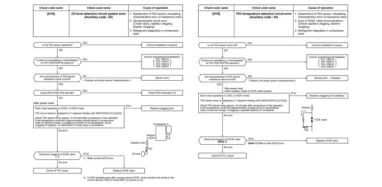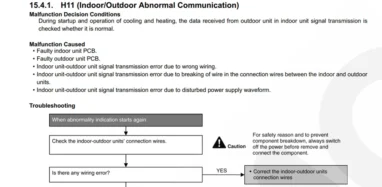Many often, I used to wonder how many people know about the various components that make up their Heating, Ventilation, and Air Conditioning (HVAC) systems. But the reality is, no one cares to know. All people care about is having a moderately warm room during winter and a comfortably cool temperature during summer.
What most people have failed to realize is how much they can save on the cost of repairs just by knowing your HVAC spare parts.
The purpose of this article is to get you accustomed to the various parts of your HVAC by addressing questions like, “what does FLA means in HVAC?” and many other questions that are related to HVAC components.
Is HVAC the same as forced air
Yes, HVAC can be considered the same thing as forced air. HVAC is any system put in place, either at home or in offices that provide thermal control and keeps the room relatively comfortable for its occupant. HVAC is made following the rules of thermodynamics and fluid mechanics.
On the other hand, forced air is a heating system mechanism that helps to regulate the internal temperature of a building so that it remains at an acceptable level. Therefore, in light of the aforementioned, it will be acceptable to consider forced air as a form of HVAC system and can be assumed to be the same because they perform similar functions.
What is FAU in HVAC
FAU is a constricted form of Forced Air Unit.
What is a forced air unit
A forced-air unit is a heat transfer medium that makes use of a central furnace to pump heat through ducts into registers often located in floors and ceilings. The heat generated by this system is taking place at a central location and transferred throughout the entire building.
How do a forced-air heating and cooling system work
The forced-air heating and cooling system works by generating air through a furnace and this air is forced out by a blower into the ductwork. This process helps convert the cold air withdrawn into heat which is then later sent across the various ducts and distributed throughout the rooms or offices through air vents.
How to regulate a forced-air heating system heat distribution
You can easily control the supply of heat to a particular room by completely shutting the air vent that links such a room.
However, if you want regulated heat in a room, you can make use of the heating system thermostat. You can do this by presetting your thermostat to the desired room temperature of your choice. So that once the room temperature drops below the preset standard on the thermostat, the furnace will automatically turn on. The thermostat will also automatically shut off the furnace once the room temperature rises above the preset standard.
What are some components found in a forced-air heating system
Forced air heating system contains components like;
- Heat exchanger
- Return ducts
- Blower
- Air plenum
- Fan limit switch
- Auxiliary heat kit
- Thermostat
- Evaporator coil
- Air filter
- Blower
Advantages of forced air systems
In recent times, the popularity of forced air systems among homeowners has reached an all-time high. This is a result of the benefits that come with them. Some of the advantages enjoyed by users of a forced-air system include;
- It has an air filter which helps to filter the air before they are distributed to the entire room. This is to ensure that the air distributed is completely clean and safe for inhabitants. Another key advantage of the filtration system is that it can be easily upgraded.
- The air from the forced air system is automatically dehumidified and is the best option for homeowners during the humid period.
- Forced air system is cost-effective and can be easily maintained because it only comes in one unit.
- It consumes lesser energy compared to some other alternatives, which means users will pay fewer power bills.
- It has a programmable thermostat that allows users to regulate the temperature level of their room.
Disadvantages of forced air systems
As much as there are many advantages attached to using a forced-air system, there are also some accompanying disadvantages. Some of these disadvantages include;
- Compared to some other available alternatives like window units, it costs more to install a forced-air unit system because, unlike the window unit, it cannot be installed unless with the help of a professional. So you might have to save extra cost for installation.
- Using a forced-air system will require ductwork which usually takes up a lot of space and there are higher chances of inefficiency.
- It is important that you clean and seal your system’s duct so they don’t become a breeding ground for mold, mildew, and some other bacteria.
- You may need to replace your filter and tune-ups regularly because they are likely to transfer allergens and that travel by distributed air.
- If usage is not properly managed or monitored, you may end up paying more on electricity bills.
- The blower is prone to occasional malfunction and this could cause the unit to become noisy or stop working altogether.
What is the difference between forced air and heat pumps
When trying to set up a cooling and heating system, most homeowners are always having to choose between forced air and the heat pump heating system This is usually a tough decision for most homeowners as each comes with its unique advantage.
Here, I will highlight the differences between these two options so that you can easily identify which one best suits your home. Some of the differences include;
- Compared to a forced-air system, a heat pump is considered more affordable and environmentally friendly.
- A forced air system generates either cold or warm air through its furnace while a heat pump system generates air from either the ground or outdoor.
- A heat pump consumes less energy compared to a forced-air system.
Which is better, forced air or heat pump
A forced-air system is better because it is more energy-efficient and provides greater value. But in general, you should consider your location before you decide on which one to choose because both work differently in different locations. For example, a forced-air system is best used in an area with extremely cold weather, while a heat pump is best used in areas with mild winter.
Note: The efficiency level of a forced-air system is greatly influenced by the type of furnace it is equipped with, so you must make your findings before you head out to buy one.
How much does it cost to replace a forced-air heating system
It will cost you between $2200 to $2800 to replace or install a forced-air heating system.
Note; The cost estimate here includes costs of material, labor, and supplies. Also, it would be important to know that cost may vary depending on your home location and where you plan to position your system.
How much does it cost to add AC to the forced air system
It will cost you between $3000 to $3500 at minimum or between $4000 to $6000 at maximum to add AC to an existing forced-air system depending on where you live and some other variables like the type of furnace and state of the existing duct.
How do you tell if you have a forced-air or heat pump
Follow the steps below to guide you on how to identify whether you have a heat pump system or a forced-air system.
- Put your thermostat in the heat setting.
- Go to the outdoor section of your heat system, check if there is any indication that signals that the system outside is running simultaneously with the heat inside, then it is a heat pump.
Another alternative is to check the labeling on the outside system. This label usually specifies whether you have a heat pump or an air conditioner.
You can also check if your thermostat has an emergency heat setting, if it does, then you have a heat pump system.
Forced air vs central air
Most times people use these two words interchangeably, perhaps because they both serve almost similar purposes, but in reality, both are different from each other.
The key difference between the two is that forced air is originally used to describe a heating system that distributes warm air around the entire house to keep it warm during cold weather. Central air on the other hand is the terminology used to describe a cooling system that helps supply the entire house with the appropriate coolness during hot weather.
Is forced air better than central air
No, forced air is not in any way better than the central air system just as the central air is not in any way better than the forced air system. The most important thing to note before opting for any of the two alternatives is to assess your requirements and compare the pros and cons of both alternatives to determine which one perfectly fits your requirement.
Curious to learn what is sensible and latent heat in HVAC or what does geothermal hvac mean?


